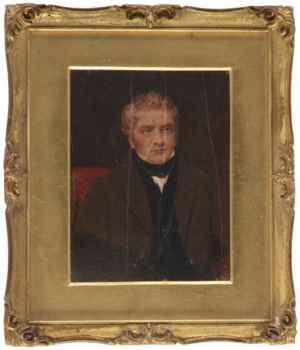Thomas Barnes (journalist) facts for kids
Quick facts for kids
Thomas Barnes
|
|
|---|---|
 |
|
| Born | 11 September 1785 London |
| Died | 7 May 1841 |
| Alma mater | |
| Occupation | Journalist |
Thomas Barnes (born September 11, 1785 – died May 7, 1841) was an English journalist and editor. He is most famous for being the editor of The Times newspaper. He led the paper from 1817 until he passed away in 1841.
Early Life and Schooling
Thomas Barnes was the oldest son of John Barnes. His father was a solicitor, which is a type of lawyer. After his mother died, Thomas was raised by his grandmother.
He started his education at Christ's Hospital, a famous school. Later, a boarding house at the school was named after him. At Christ's Hospital, he was classmates with Leigh Hunt. Hunt later became a well-known writer.
From there, Barnes went to Pembroke College, Cambridge, a university. He was very good at his studies and sports. He studied classics, which means ancient Greek and Roman history and literature. He earned his degree in 1808.
After university, Barnes thought about becoming a professor. However, his family wanted him to study law. So, in 1809, he moved to London and began working as a lawyer.
While working, Barnes joined a group of famous writers. This group included Leigh Hunt, Charles Lamb, and William Hazlitt. Barnes enjoyed going to plays and shows in London's West End.
Career in Journalism
Barnes found his law job boring. He wanted to use his talents in a different way. He became friends with Barron Field, who was a theatre critic for The Times newspaper.
Through Field, Barnes met John Walter, who owned The Times. Walter soon hired Barnes as a journalist. Barnes wrote about law cases, politics, and theatre.
When Field retired, Barnes took over as the theatre critic. In 1811, he started working on the newspaper's parliamentary staff. This meant he wrote about what was happening in Parliament. He collected some of these writings into a book called Parliamentary Portraits in 1815. During this time, he also wrote for Leigh Hunt's newspapers, Examiner and the Reflector.
Editor of The Times
John Walter trusted Barnes a lot. In 1815, Walter asked Barnes to fix the main articles of the paper. These articles were called leading articles. The editor at the time, John Stoddart, wrote articles that were too strong and caused problems.
At the end of 1816, Stoddart was fired. Barnes was then chosen to be the new editor. He held this important job until he died. As editor, Barnes had more control over the newspaper than previous editors. He even owned a part of the paper.
Barnes used his power to change The Times. He wanted the paper to analyze events, not just summarize them. He made the leading article the most important part of the newspaper.
After the Peterloo Massacre in 1819, Barnes decided The Times would support the Whig political party. This was different from the previous editor, who supported the Tory party. Barnes became good friends with Henry Brougham, a Whig leader. Brougham gave Barnes important information for his articles.
During Barnes's time as editor, The Times became very powerful. Its influence grew in public affairs. Barnes visited Ireland and was moved by what he saw. He became a strong supporter of Catholic Emancipation. This was a movement to give Catholics more rights.
By the early 1830s, The Times was nicknamed "The Thunderer." Robert Peel, a famous politician, said it was "a powerful advocate of Reform." Another politician, Lord Lyndhurst, called Barnes "the most powerful man in the country."
Around this time, Barnes's political views changed. He opposed the Poor Law Amendment Act of 1834. This law changed how aid was given to poor people. He also had a disagreement with his friend Brougham.
Barnes also had disagreements with Lord Palmerston, a government leader. Palmerston tried to control what the public thought about foreign affairs. He would leak secrets and release letters to the press. He wanted to make himself look good and make British people feel very patriotic. Barnes refused to help Palmerston with these plans.
Personal Life
Thomas Barnes never got married. However, he had a relationship with Dinah Mary Mondet for over twenty years. They lived together in London. First, they lived at 49 Nelson Square from 1821 to 1836. Then, they moved to 25 Soho Square.
After Barnes died in 1841, Dinah Mondet continued to live in their home. She lived there until she died in 1852. She was buried next to Barnes in Kensal Green Cemetery.

